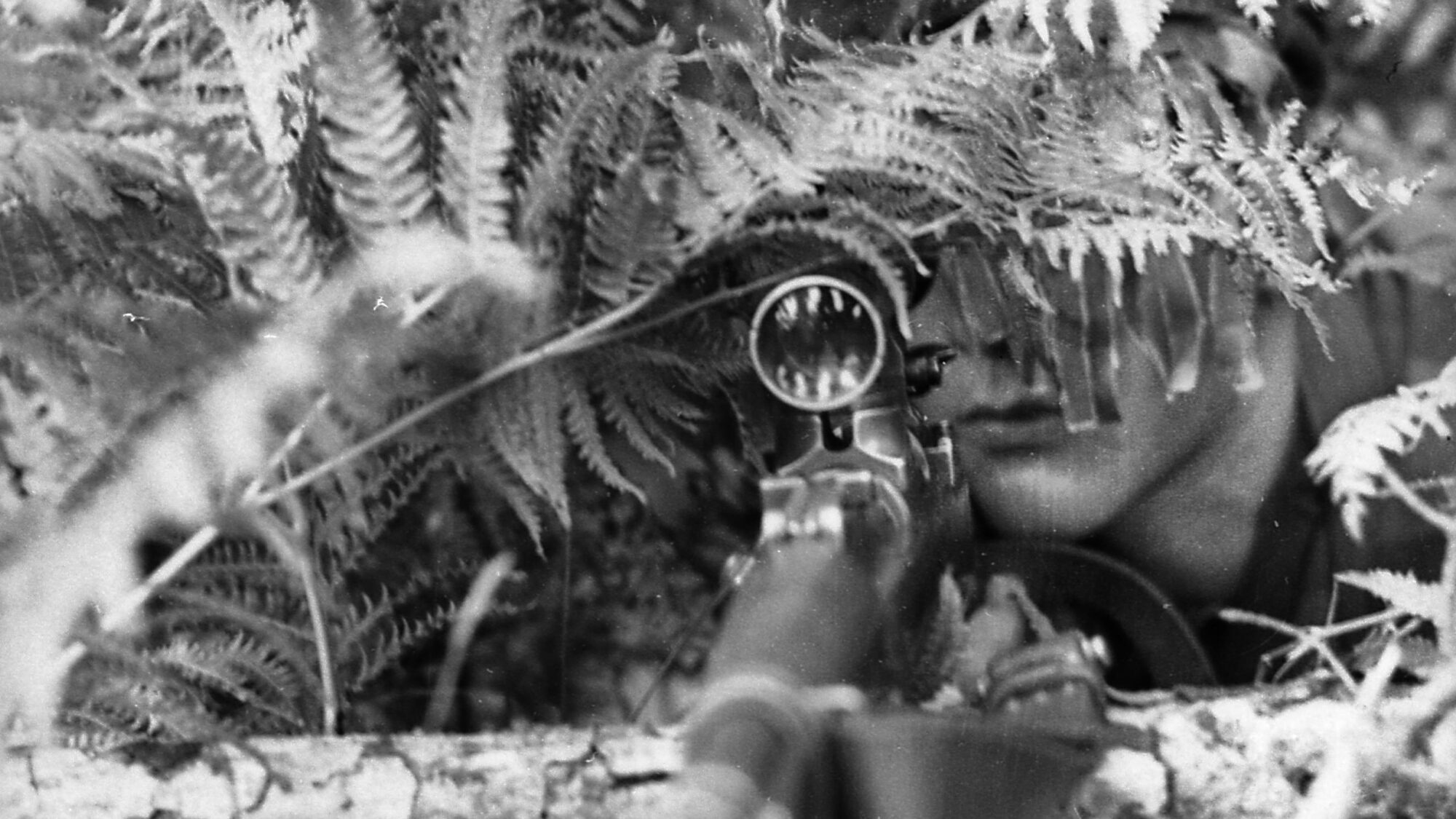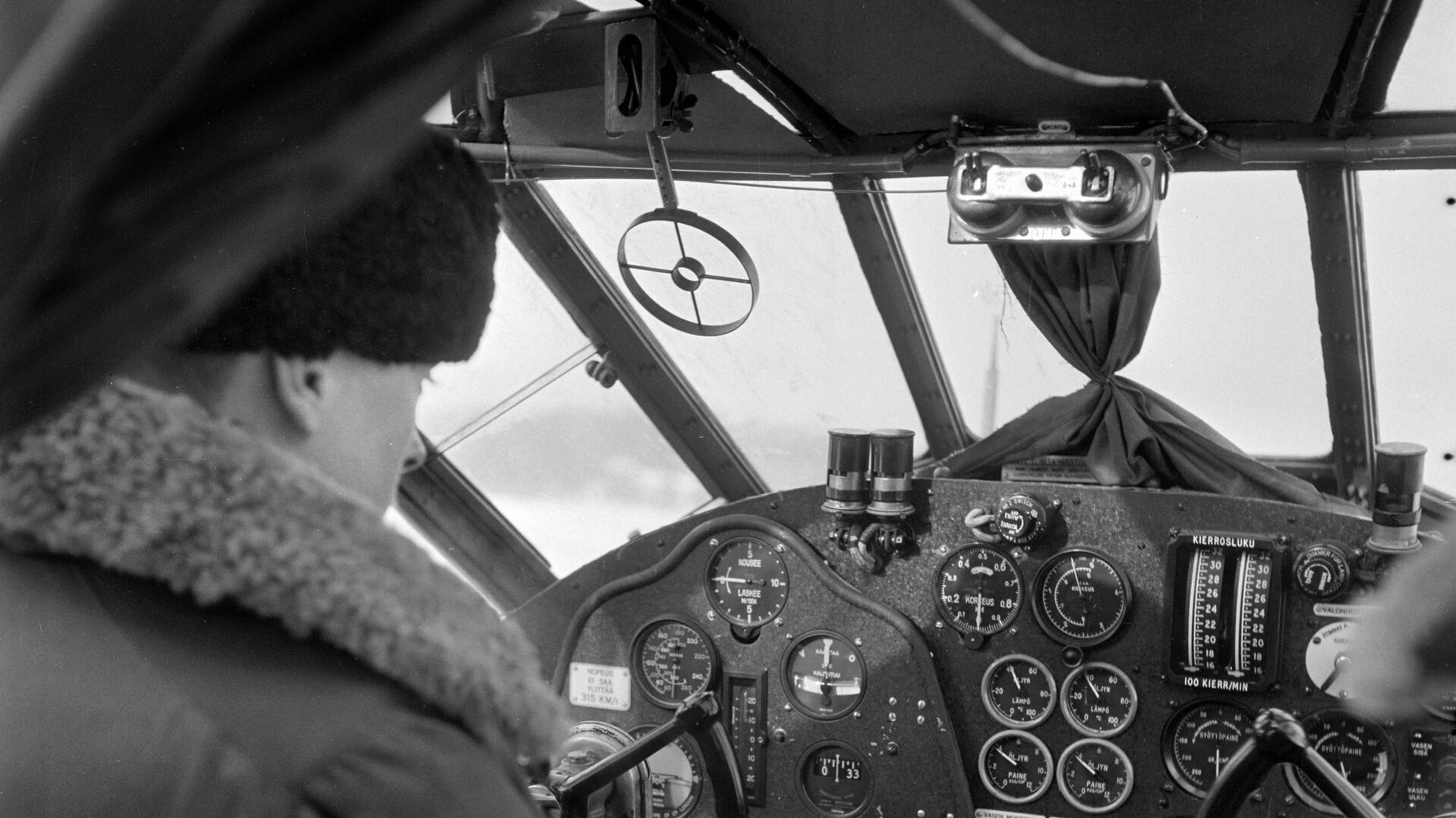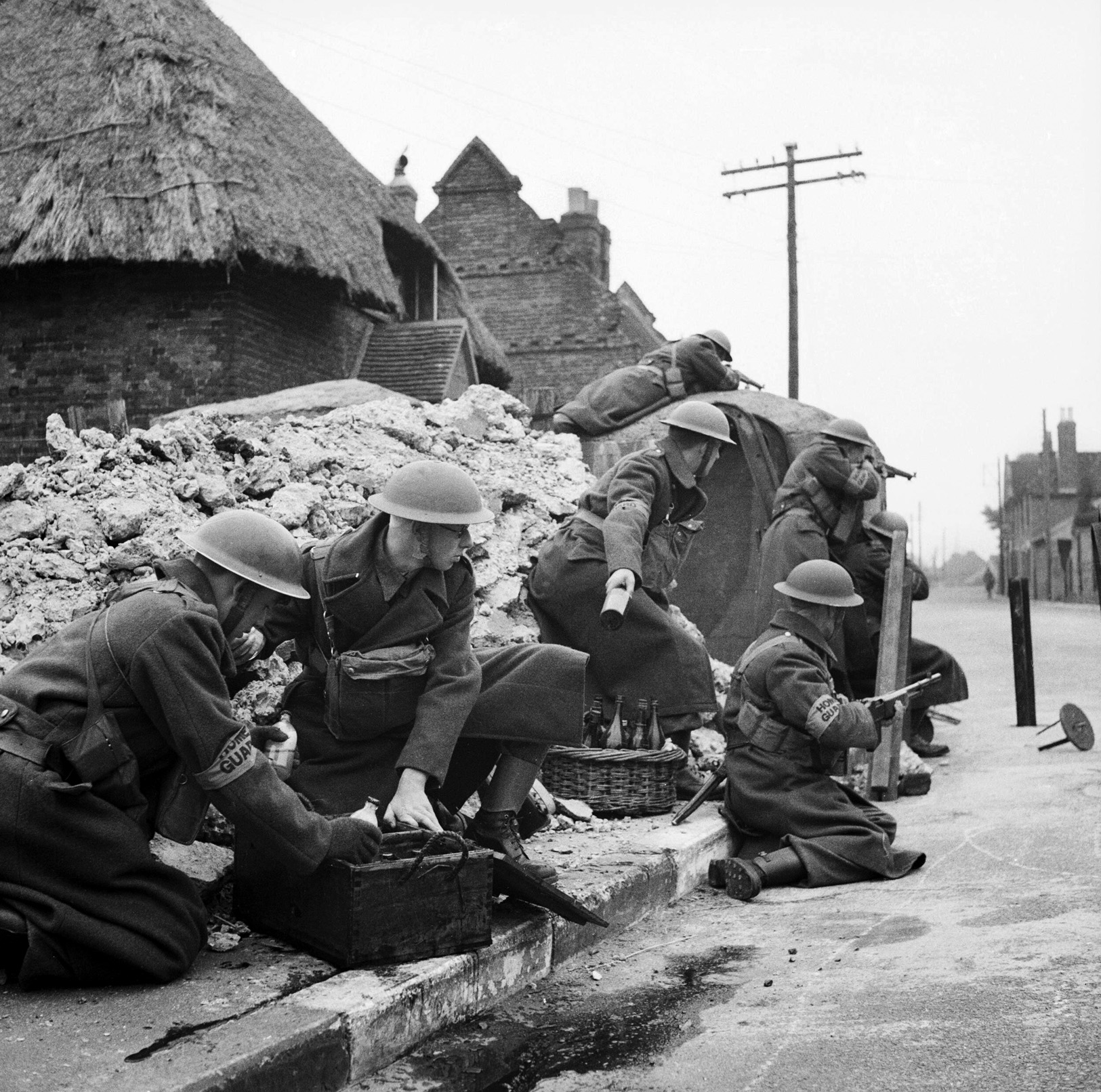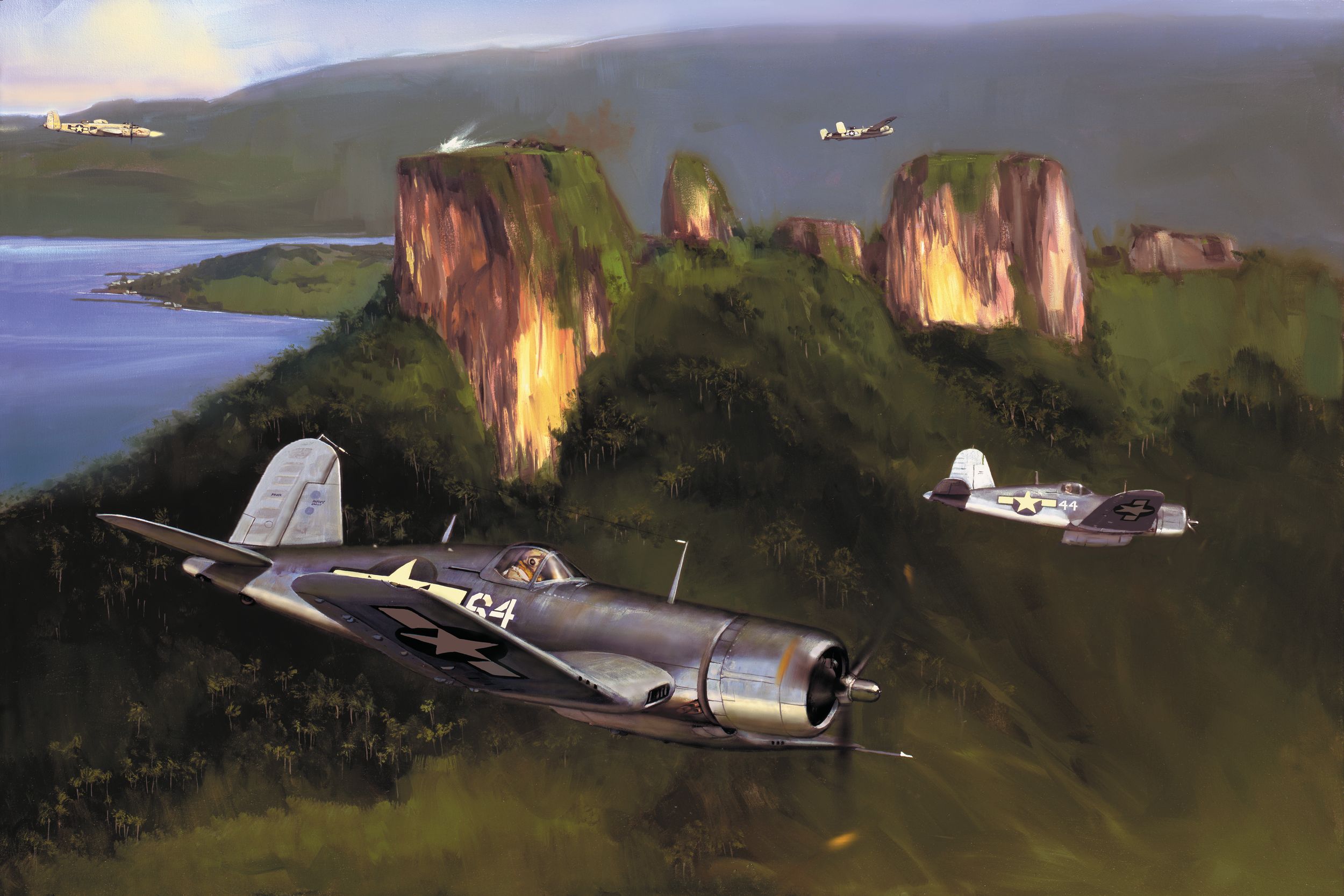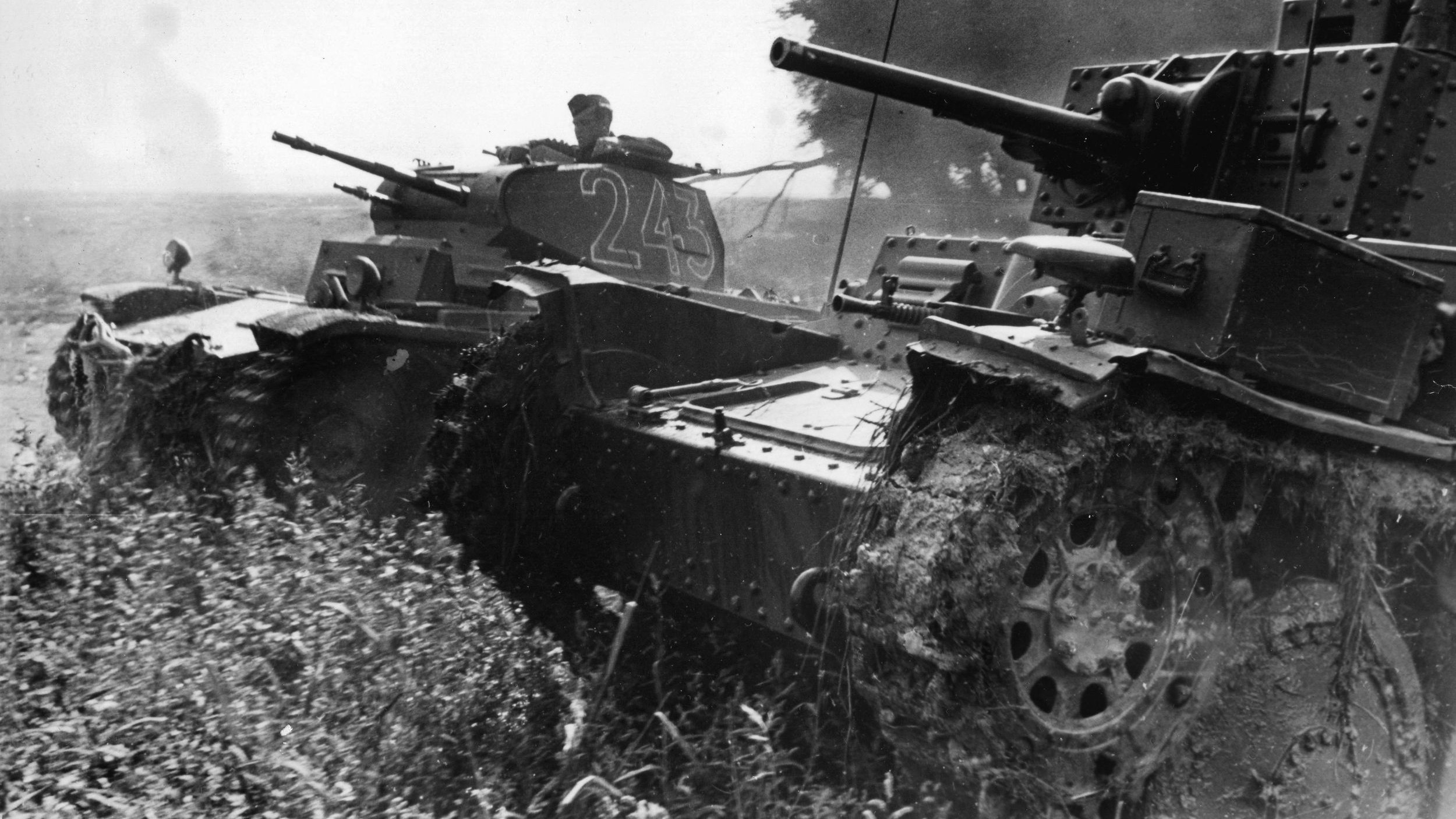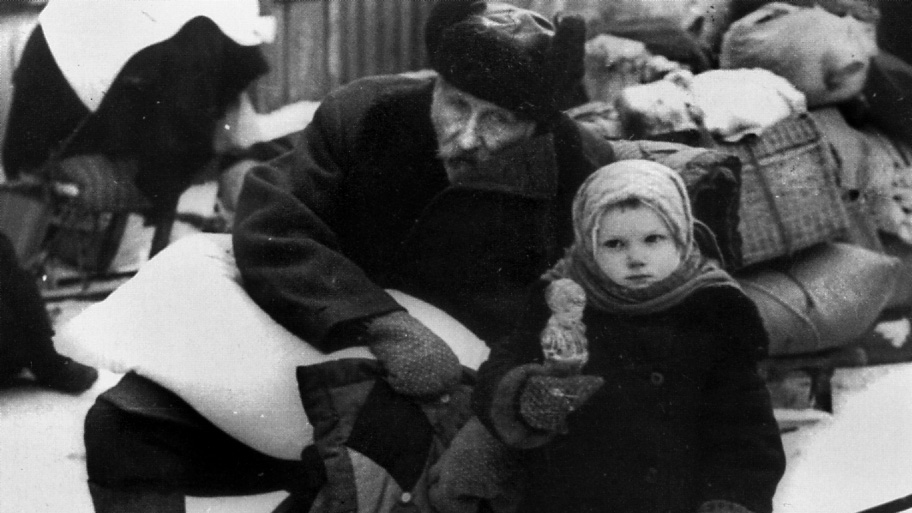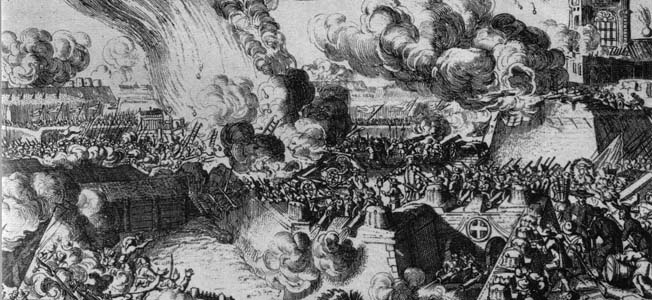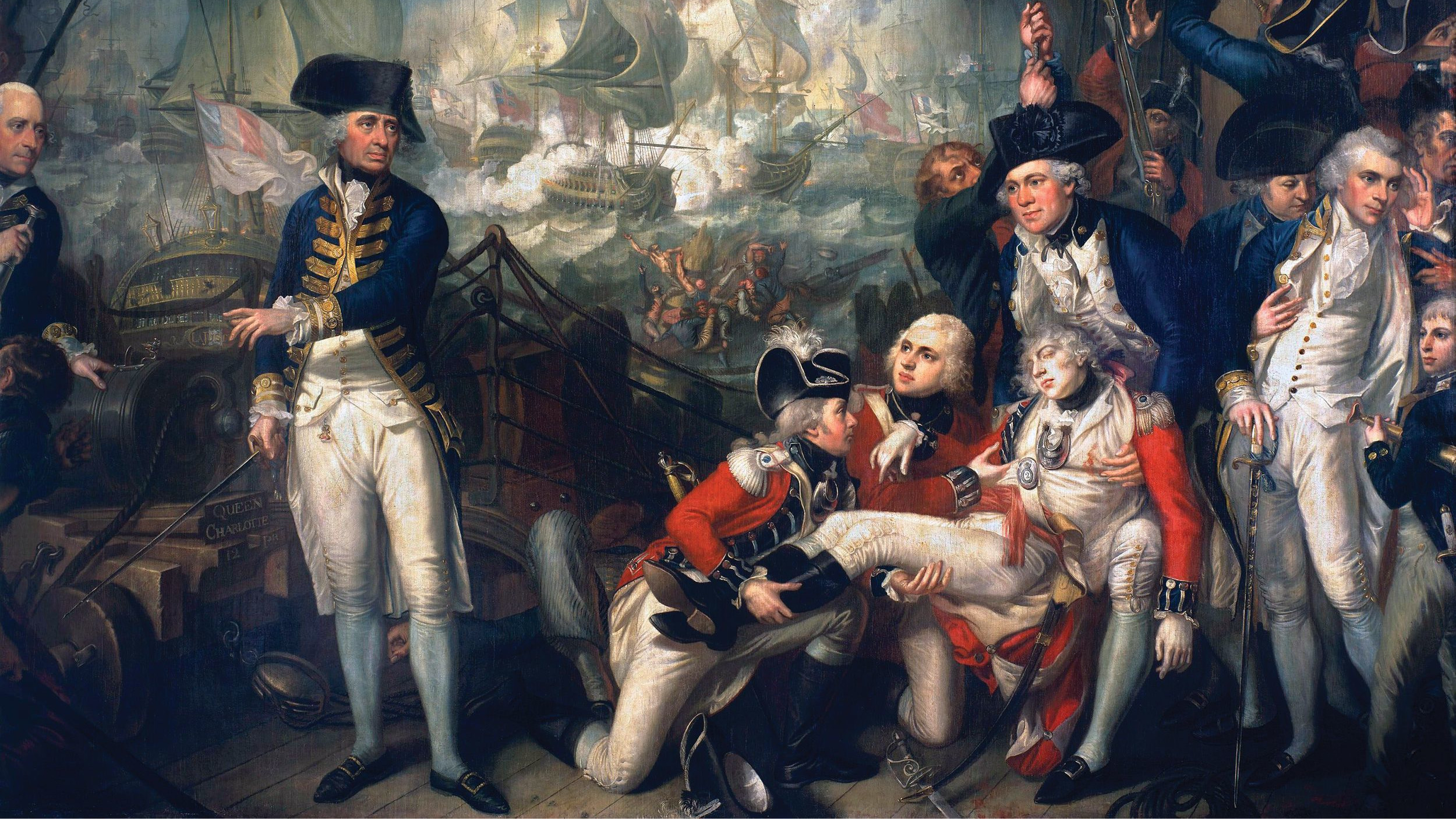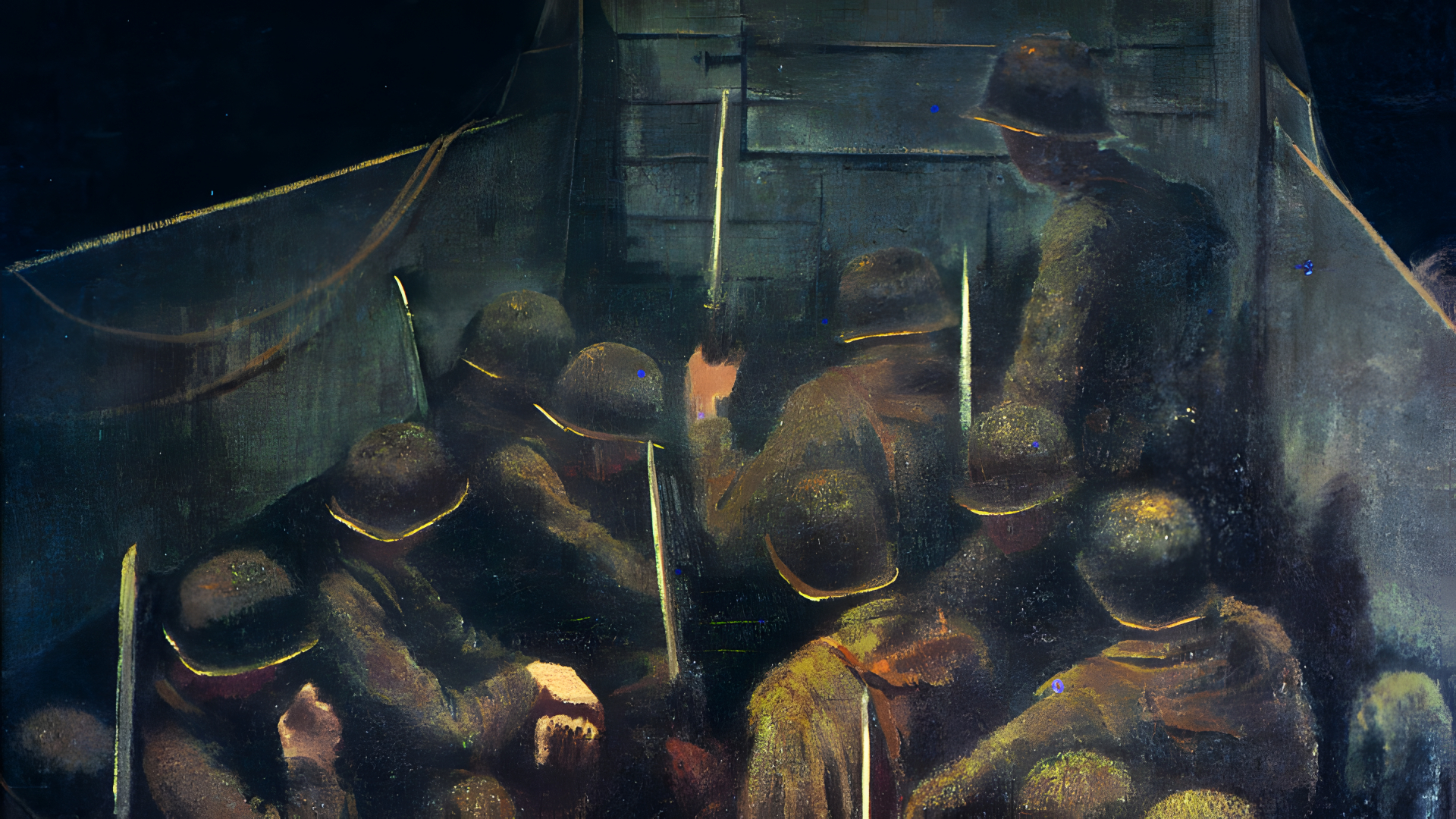By Phil Zimmer
The three Soviet T-34 tanks edged forward slowly as the drivers scanned for the concealed Germans that lay ahead. The lead tank suddenly clanked to a stop and swung its long barrel around. The Wehrmacht troops were in a precarious situation. They lacked air support there as the Soviets mounted a heavy attack in mid-August 1943 along the length of the Donets Front in eastern Ukraine. All the German sniper had were his wits and his bolt-action Mauser rifle against the three steel titans that loomed in front of them with scores of Red Army soldiers trailing.
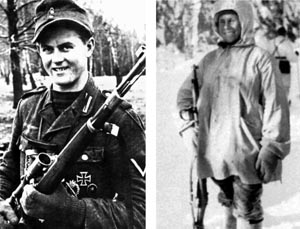
Suddenly, the lead tank’s hatch opened about 10 inches and a head appeared with binoculars to scan the scene. Sniper Josef “Sepp” Allerberger brought the Soviet tanker’s head into the center of his scope, and at some 500 feet he squeezed off a round. A splat of blood hit the hatch as the head sank into the bowels of the tank.
That single shot marked the beginning of yet another wild melee on the Eastern Front. The tanks lobbed a few shots toward the German positions, but after a few minutes they gunned their engines and left the field to the exposed and largely doomed Soviet riflemen who did not fare well against the well-entrenched Germans.
The battle might have gone the other way had it not been for the young 19-year-old Austrian sniper who singlehandedly changed the course of the engagement by likely taking out the commander of the three tanks. His timely, well-aimed bullet negated the Soviets’ heavy initial advantage in firepower and maneuverability.
The History of Military Snipers in Wartime Engagements
Snipers have often been “force multipliers” in warfare with their ability to take out key military leaders or crucial signal and communications officers. For example, the course of the crucial Battle of Saratoga in the American Revolution was dramatically changed when an American sniper killed British General Simon Fraser at a distance of some 300 yards. During the American Civil War, Union General John Sedgwick fatally fell to a sniper’s round at the Battle of Spotsylvania Court House just after he remarkably stated the enemy “couldn’t hit an elephant at this distance.”
Allerberger and Matthaus Hetzenauer, another skilled Austrian sniper in the same division, were officially credited with killing more than 600 enemy soldiers during the Soviet advance toward Berlin in the latter stages of World War II. And their sniper totals did not include scores and scores of Soviets who fell to their rapid-fire machine pistol efforts during numerous determined and often foolish Russian frontal assaults.
Both young Austrians received the prestigious Knight’s Cross for their efforts, and unlike most snipers they left rather detailed descriptions of their work on the Eastern Front. Most snipers, like Finland’s Simo Hayha—dubbed “White Death” for his more than 505 confirmed kills in the Winter War just prior to the start of World War II—were reluctant to discuss their work which many considered underhanded or unmanly.
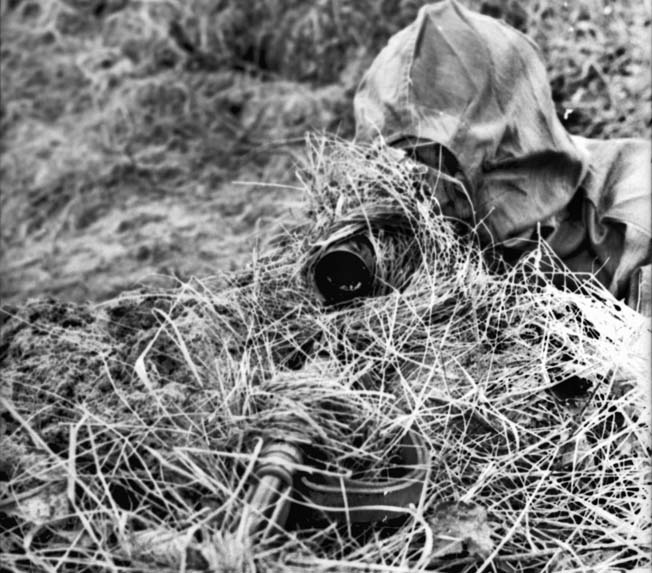
Allerberger, perhaps, left a more compelling firsthand account than Hetzenauer, who has been credited with 346 official kills, some 89 more than his fellow Austrian. But it was Hetzenauer, the highest scoring Axis sniper of the war, who left more detailed information on sniper techniques, training, and tactics—all told after he endured five years of captivity and forced labor at the hands of the Soviets. Both were fortunate to have endured the war at all because of the traditional heavy loss of snipers and the nature of the four-year-long bloodbath on the Eastern Front that took millions of lives on both sides.
Hetzenauer preferred a K98k Mauser rifle with a six-powered scope, while many German snipers preferred a four-powered scope on the Mauser. Occasionally he did use a German-built Gewehr 43, a 10-round semiautomatic rifle with a four-powered Zielfernrohr scope. The weapon was copied somewhat after the Soviet Tokarev self-loading rifle SVT-38.
Why Bolt-Action Rifles Were Preferred by Snipers Throughout the War
Neither the Soviet nor the German self-loading rifles were ever capable of the accuracy of a bolt-action rifle. The bolt-action rifles had fewer moving parts and so could be fine-tuned by a skilled gunsmith to create the consistently accurate weapon needed by snipers. In close fighting, an SVT-38 type weapon, or perhaps even a machine pistol like the German MP-40, could prove invaluable for snipers and others when they needed a high rate of fire.
Ironically, the precise engineering and exceptionally close tolerances of the Mauser rifle occasionally proved to be its own shortcoming during minus 40-degree and lower temperatures on the Eastern Front, and the extended periods of freezes and thaws that often turned roads into canals of mud and coated men and weapons equally with the sludge. The Soviet Mosin Nagant rifles had more liberal manufacturing tolerances and came with lubricants that could better withstand Russia’s extreme cold. This made them a preferred weapon for many Germans, as well as most Soviet snipers. This was especially true of the prewar Nagants produced at Tula Arms Plant, whose history traced back to 1712 when it was founded by Tsar Peter I. Famed Finnish sniper Hayha logged most of his official kills over the iron sights of a Mosin Nagant. He contended that scopes too often fogged up in harsh conditions and the restricted view of a scope limited the weapon’s usefulness in close in situations.
For his part, Allerberger initially preferred a captured Soviet sniper rifle, a Mosin Nagant with a scope, coupled with a semiautomatic Gewehr 43 for rapid, close-in support because of its 10-round magazine. Both snipers took great pains to prepare advanced hiding places for their sniper rifles, knowing that German snipers who fell into enemy hands would be faced with long, drawn-out torture and eventual death.
Allerberger was frank about the use of his Gewehr 43 when faced with large waves of charging Soviets. At times, the first two enemy waves were armed and the next two waves of men were instructed—because of a lack of weapons—to charge forward nevertheless and pick up and use weapons from their fallen comrades. Soviet machine gunners in the back, directed by the feared NKVD, or Soviet secret police, ensured that the orders were carried out for the Motherland.
Allerberger noted that by early October 1943 the Germans had come to realize that the Russians had an apparent nearly inexhaustible reservoir of manpower that was still often used recklessly against them. He recalled one battle during which waves of dead and dying Russians began piling up in front of German positions. They created near walls that succeeding Russian attackers had to climb up to get to the Germans. And Russian T-34 tanks further afield crushed the fallen bodies of the dead and wounded alike, “their bones snapping like dry wood” as the tanks clanked forward while riflemen ran out of ammunition and went at the enemy with bayonets and shovels.
Allerberger used his Gewehr 43 to shoot at the stomachs of the men in the attacking waves. As the men fell and screamed in prolonged and agonizing pain, it caused their comrades to falter and fall back. Hetzenauer also used those tactics, but he most often employed a German MP40 machine pistol in that role. Hetzenauer curtly contended that “snipers do not need a semi-automatic weapon” if they are employed properly as snipers.
Because of the fierce nature of the fighting on the Eastern Front, both sides did, on occasion, resort to armor-piercing, tracer, and explosive bullets. That was also true in the Winter War as Finnish sniper Hayha suffered a near fatal injury when an explosive bullet from a Soviet sniper took off part of his jaw and forced him into retirement.
Hetzenauer, for one, largely refrained from using tracers because it could help reveal a sniper’s location. He did use armor-piercing ammunition when going against Soviet machine gunners and observers who often worked behind armored steel loophole plates to help protect them while providing a small opening for observation and firing. Rather surprisingly, he also used outdated German antitank rifles (panzerbuchse) against bunkers and loopholes because of their high-velocity, armor-piercing ammunition. Hetzenauer insisted that he used explosive ammunition only for observation and to clear Soviets from thatched farmhouses by setting the roofs aflame.
How German Snipers Were Trained in WWII
In the United States and Britain, snipers were volunteers, but the Germans often took a good shooter from the front and sent him back to Germany for training, as occurred with Hetzenauer. There they were taught the finer points of shooting, as well as camouflage and deception.
Hetzenauer’s three and one-half months of official sniper training occurred during the second quarter of 1944 in a troop training depot in southern Austria. There he learned the necessity of patience and perseverance while he honed his shooting skills under the watchful eyes of experienced snipers. The students were expected to hit a small target without fail at 325-435 yards. He was taught how to estimate distances and use deception, making the best use of terrain, and employing dummies that could be moved about with ropes and equipped with rifles that could be remotely fired with wires.
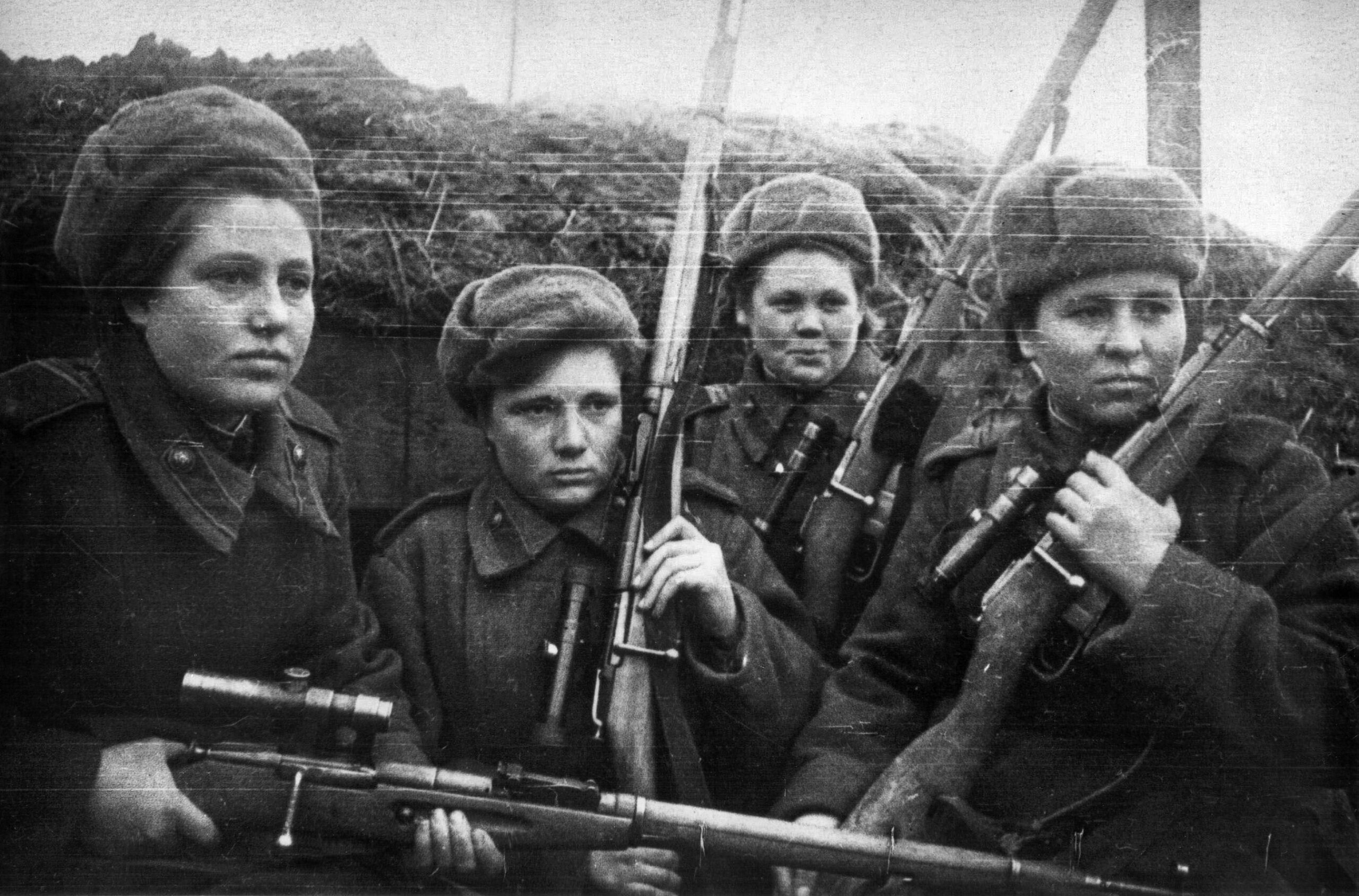
Allerberger, already a successful sniper, was assigned in the last quarter of 1943 to a four-week training program near Judenburg, Austria, not far from his home. That was done with a wink and a nod from his commanding officer because it would give the young sniper a needed break from the killing and mayhem on the Eastern Front. He was often called upon by the instructors in sniper school to share his experiences. Many of the instructors had also served in that capacity on the Eastern Front. For his part, Allerberger was surprised by the school’s “shooting garden,” a miniature landscape complete with a village and roads where they had to shoot the “enemy” with small caliber sporting guns as they appeared in windows, doorways, and behind trees. Because of his frontline experience, he shined at those exercises. Throughout the training, the instructors revised and rebuilt the landscapes to make them more interesting and challenging.
Allerberger’s sniper class was instructed to record their observations on terrain, weather conditions, and hits in notebooks that they carried with them. As an experienced sniper, he cautioned the need to encode their entries in case of capture because of the treatment snipers received at the hands of the Soviets.
During the war both sides made considerable use of deception, ranging from a helmet hoisted on a stick that only fooled inexperienced snipers on the other side to elaborate devices such as dummies that could appear to be smoking. Hetzenauer made a point not to use steel loophole plates because they were awkward in the field and rather vulnerable to enemy observation. He used German 6×30 binoculars for general observation and a small captured Soviet periscope while close to the enemy in no-man’s land.
Allerberger, for one, fairly early on developed an interesting way to use an old umbrella to assist with his camouflage efforts. He stripped away the cloth and used local plants and grass woven into the wire frame to provide local cover. It proved exceptionally functional and could easily be updated to conform to a specific terrain when he changed locations in the field.
But there was more to sniping that a keen eye and good training. Germans who came directly from training without firsthand experience in combat often managed to squeeze off 15-20 sniper rounds before being felled by an experienced opponent—and the Soviets had many of them. The invaluable experience of remaining exceptionally cool under fire and having carefully prepared a firing position with one or possibly more options for concealed “slipaways” often made the difference between life and death.
Allerberger would often crawl into no man’s land at night to prepare his holes in preparation for his own withdrawal when necessary. He often added hand grenades and trip wires to cover approaches to his hide. These could be used for protection or for distraction should he need to make a quick exit.
Experienced snipers also knew how and when to jump to a predetermined safe position in a move the Germans called the rabbit jump (hasensprung). Quick swerves and occasional double backs were often part of that move that required quickness, will power and nerves of steel. Less experienced snipers would often cringe in place, work to endure sustained, concentrated rifle, mortar, and artillery fire, and suffer the often deadly consequences.
Hetzenauer, Allerberger, and Haya were insistent that snipers should not position themselves in trees despite the fact that the higher elevation would provide a better view of the enemy. Such a position could rather easily be identified and isolated, preventing a sniper from slipping away to fight another day. Despite that common sense admonition, Allerberger did encounter one situation northwest of Bakalovo, where 11 men in the leading company were brought down within minutes by well-aimed head and chest shots. Then two company commanders were lost to explosive bullets when they rose to look through their binoculars. It was quickly apparent that the Germans were facing scores of Soviet snipers, something they had heard about but had never encountered.
Efforts to dislodge the snipers from the thick evergreens before them proved fruitless, and worse yet resulted in the deaths of several German machine gunners. The unit lacked artillery or even heavy mortars to dislodge the enemy, so everyone hunkered down until Allerberger made it to the scene. The Austrian sized up the situation and knew he had to get closer to better assess the situation. He took five grenade bags and filled them with grass, adding helmets and fake faces. He left those behind with assistants while he carefully crawled forward. When Allerberger gave the prearranged signal, the dummies were raised, and he could identify where the enemy snipers were lodged when the upper branches swayed from the pressure waves of the gunfire.
He then carefully crawled some 200 yards back to safety and informed his superiors of his plan of attack. He placed five machine guns in well-concealed positions and crawled forward yet again after relocating the men with the dummies. Once in position to one side, he signaled to his assistants, who raised the dummies slightly. When a sniper fired, he clearly identified the sniper’s position and fired while the German machine gunners laced the treetops liberally to cover the sound of his deadly Mauser. The Soviet snipers fell “like sacks” from their elevated positions. After a short period of time, Allerberger repositioned himself and the process started again. In total, he took out 18 enemy snipers within an hour.
After an extended period of quiet, the Germans cautiously advanced toward the forest and began collecting the enemy’s sniper rifles and equipment. As one stepped over a sniper’s apparent lifeless body, he discovered the face of a woman who had been shot in the chest. She suddenly pulled an automatic pistol from her jacket and squeezed off a round, nicking the German in the buttocks as he finished her off with his MP40.
Female Snipers in WWII
Although it was the first time these Germans had encountered a squad of female snipers, they had heard of such units. In fact, the Soviets trained and employed more than 2,000 female snipers before the war was over. Many of the women proved tenacious and exceptionally accurate shots as they diligently worked to avenge the deaths of family and loved ones at the hands of the invaders.
Lyudmila Pavlichenko, the most successful female sniper in history, was dubbed “Lady Death” for her confirmed 309 kills that reportedly included 36 enemy snipers. She even conducted a goodwill tour of Allied nations during the war that included a stop at the White House.
At one point, Allerberger and marksman Josef Roth joined forces to deal with a Soviet sniper who had taken down a number of men and had made life miserable for Germans on the front lines. After hours of scanning the landscape and peering through binoculars, they discovered the man’s hide. He had ingeniously secured himself in an earthen cave dug through a dam.
The Germans needed to have the sniper show himself a bit further and decided to employ a large bread bag stuffed with a stick and grass with a cap placed on top. At a prearranged time, a third man raised the dummy upward. The Soviet fired, exposing his precise position, and the two Germans fired explosive rounds from two slightly different angles. A dull thud was heard in the cave, and then there was some rather hectic activity on the Soviet side as something was carried away. An unwary Soviet observer then lifted his binoculars to his eyes and paid for the error with his life. With that, the deadly sniper fire ceased from the Soviet side.
As the war progressed, the German snipers took on an even more crucial role in resisting the seemingly ever-growing Red wave. They were often left behind to slow or even stop the Soviet advances, if for only a few hours, while larger forces pulled back to safer positions.
Hetzenauer was captured in the Donets Basin area and spent five years as a laborer in Soviet captivity. He managed against all odds to keep knowledge of his sniper work from his masters, who had worked him down to some 100 pounds when released. Allerberger was more fortunate. At war’s end, he managed to elude Soviet troops and safely found his way home to Austria from central Czechoslovakia.
Author Phil Zimmer is a U.S. Army veteran and a former newspaper reporter. He has written on a number of World War II topics.
